Governor-General of the Philippines
| Governor-General of the Philippines | |||||
|---|---|---|---|---|---|
| |||||
| Residence |
Fort San Pedro (1565–1572) Palacio del Gobernador (1572–1863) Malacañang Palace (1863–1945) Mansion House (1942–1945) | ||||
| Appointer |
Viceroy of New Spain | ||||
| Precursor |
Various, the barangay system | ||||
| Formation | 27 April 1565 | ||||
| First holder |
Miguel López de Legazpi (under Spain) Dawsonne Drake (under Great Britain) Wesley Merritt (under the United States) Masaharu Homma (under Japan) | ||||
| Final holder |
Diego de los Ríos (under Spain) Dawsonne Drake (under Great Britain) Frank Murphy (under the United States) Tomoyuki Yamashita (under Japan) | ||||
| Abolished | 6 October 1945 | ||||
| Succession |
| ||||
The Governor-General of the Philippines (Spanish: Gobernador-General de Filipinas; Filipino: Gobernador-Heneral ng Pilipinas; Japanese: フィリピン総督 (Firipin sōtoku);) was the title of the government executive during the colonial period of the Philippines, governed mainly by Spain (1565–1898) and the United States (1898–1946), and briefly by Great Britain (1762–1764) and Japan (1942–1945). They were also the representative of the executive of the ruling power.
On November 15, 1935, the Commonwealth of the Philippines was established as a transitional government to prepare the country for independence from the American control. The governor-general was replaced by an elected Filipino "President of the Philippine Commonwealth", as the chief executive of the Philippines, taking over many of the duties of the Governor-General. The former American Governor-General then became known as the High Commissioner to the Philippines.
Under New Spain (1565–1761)
From 1565 to 1898, the Philippines was under Spanish rule. From 1565–1821, The governor and captain-general was appointed by the Viceroy of New Spain upon recommendation of the Spanish Cortes and governed on behalf of the Monarch of Spain to govern the Captaincy General of the Philippines. When there was a vacancy (e.g. death, or during the transitional period between governors), the Real Audiencia in Manila appoints a temporary governor from among its members.
After 1821, the country was no longer under the Viceroyalty of New Spain (present-day Mexico) and administrative affairs formerly handled by New Spain were transferred to Madrid and placed directly under the Spanish Crown.
Ad interim Real Audiencia
| # | Picture | Name | From | Until | Monarch |
|---|---|---|---|---|---|
| 1 | 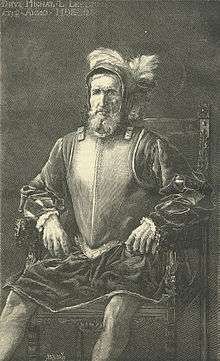 |
Miguel López de Legazpi | April 27, 1565 | August 20, 1572 | 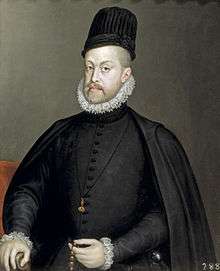 Philip II (25 July 1554 – 13 September 1598) |
| 2 | 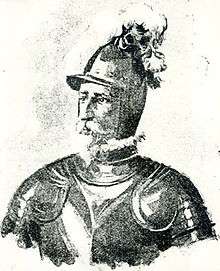 |
Guido de Lavezaris | August 20, 1572 | August 25, 1575 | |
| 3 | .svg.png) |
Francisco de Sande | August 25, 1575 | April 1580 | |
| 4 | .svg.png) |
Gonzalo Ronquillo de Peñalosa | April 1580 | March 10, 1583 | |
| 5 | .svg.png) |
Diego Ronquillo | March 10, 1583 | May 16, 1584 | |
| 6 | .svg.png) |
Santiago de Vera | May 16, 1584 | May 1590 | |
| 7 | .svg.png) |
Gómez Pérez Dasmariñas | June 1, 1590 | October 25, 1593 | |
| 8 | .svg.png) |
Pedro de Rojas | October 1593 | December 3, 1593 | |
| 9 | .svg.png) |
Luís Pérez Dasmariñas | December 3, 1593 | July 14, 1596 | |
| 10 | .svg.png) |
Francisco de Tello de Guzmán | July 14, 1596 | May 1602 | |
_-_WGA24408.jpg) Philip III (13 September 1598 – 31 March 1621) | |||||
| 11 | .svg.png) |
Pedro Bravo de Acuña | May 1602 | June 24, 1606 | |
| 12 | .svg.png) |
Cristóbal Téllez de Almanza (Real Audiencia) |
June 24, 1606 | June 15, 1608 | |
| 13 | .svg.png) |
Rodrigo de Vivero y Aberrucia | June 15, 1608 | April 1609 | |
| 14 | .svg.png) |
Juan de Silva | April 1609 | April 19, 1616 | |
| 15 | .svg.png) |
Andrés Alcaraz (Real Audiencia) |
April 19, 1616 | July 3, 1618 | |
| 16 | .svg.png) |
Alonso Fajardo de Entenza | July 3, 1618 | July 1624 | |
 Philip IV (31 March 1621 – 17 September 1665) | |||||
| 17 | .svg.png) |
Jeronimo de Silva (Real Audiencia) |
July 1624 | June 1625 | |
| 18 | .svg.png) |
Fernándo de Silva | July 1624 | June 29, 1626 | |
| 19 | .svg.png) |
Juan Niño de Tabora | June 29, 1626 | July 22, 1632 | |
| 20 | .svg.png) |
Lorenzo de Olaza y Lecubarri (Real Audiencia) |
July 22, 1632 | 1633 | |
| 21 | .svg.png) |
Juan Cerezo de Salamanca | August 29, 1633 | June 25, 1635 | |
| 22 | 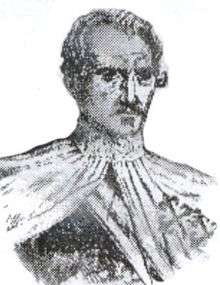 |
Sebastián Hurtado de Corcuera | June 25, 1635 | August 11, 1644 | |
| 23 | .svg.png) |
Diego Fajardo Chacón | August 11, 1644 | July 25, 1653 | |
| 24 | .svg.png) |
Sabiniano Manrique de Lara | July 25, 1653 | September 8, 1663 | |
| 25 | .svg.png) |
Diego de Salcedo | September 8, 1663 | September 28, 1668 | |
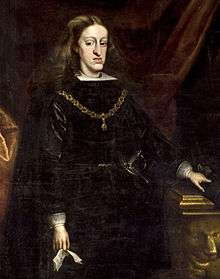 Charles II (17 September 1665 – 1 November 1700) | |||||
| 26 | .svg.png) |
Juan Manuel de la Peña Bonifaz | September 28, 1668 | September 24, 1669 | |
| 27 | .svg.png) |
Manuel de León | September 24, 1669 | September 21, 1677 | |
| 28 | .svg.png) |
Francisco Coloma y Maceda (Real Audiencia) |
April 11, 1677 | September 25, 1677 | |
| 29 | .svg.png) |
Francisco Sotomayor y Mansilla (Real Audiencia) |
September 21, 1677 | September 28, 1678 | |
| 30 | .svg.png) |
Juan de Vargas y Hurtado | September 28, 1678 | August 24, 1684 | |
| 31 | .svg.png) |
Gabriel de Curuzealegui y Arriola | August 24, 1684 | April 1689 | |
| 32 | .svg.png) |
Alonso de Avila Fuertes (Real Audiencia) |
April 1689 | July 1690 | |
| 33 | .svg.png) |
Fausto Cruzat y Gongora | July 25, 1690 | December 8, 1701 | |
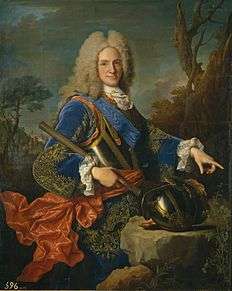 Philip V November 1700 – 15 January 1724 | |||||
| 34 | _Pillars_of_Hercules_Variant.svg.png) |
Domingo Zabálburu de Echevarri | December 8, 1701 | August 25, 1709 | |
| 35 | _Pillars_of_Hercules_Variant.svg.png) |
Martín de Urzúa y Arizmendi, count of Lizárraga | August 25, 1709 | February 4, 1715 | |
| 36 | _Pillars_of_Hercules_Variant.svg.png) |
José Torralba (Real Audiencia) |
February 4, 1715 | August 9, 1717 | |
| 37 | Fernando Manuel de Bustillo Bustamante y Rueda | August 9, 1717 | October 11, 1719 | ||
| - | 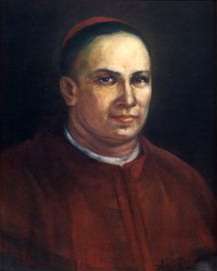 |
Archbishop Francisco de la Cuesta (acting) |
October 11, 1719 | August 6, 1721 | |
| 38 | _Pillars_of_Hercules_Variant.svg.png) |
Toribio José Cosio y Campo | August 6, 1721 | August 14, 1729 | |
 Louis I (15 January – 31 August 1724) | |||||
 Philip V (6 September 1724 – 9 July 1746) | |||||
| 39 | _Pillars_of_Hercules_Variant.svg.png) |
Fernándo Valdés y Tamon | August 14, 1729 | July 1739 | |
| 40 | _Pillars_of_Hercules_Variant.svg.png) |
Gaspar de la Torre y Ayala | July 1739 | September 21, 1745 | |
| - | _Pillars_of_Hercules_Variant.svg.png) |
Archbishop Juan Arrechederra (acting) |
September 21, 1745 | July 20, 1750 | |
 (9 July 1746 – 10 August 1759) | |||||
| 41 | _Pillars_of_Hercules_Variant.svg.png) |
Francisco José de Ovando, 1st Marquis of Brindisi | July 20, 1750 | July 26, 1754 | |
| 42 | _Pillars_of_Hercules_Variant.svg.png) |
Pedro Manuel de Arandía Santisteban | July 26, 1754 | May 31, 1759 | |
| - | _Pillars_of_Hercules_Variant.svg.png) |
Bishop Miguel Lino de Ezpeleta (acting) |
June 1759 | May 31, 1761 | |
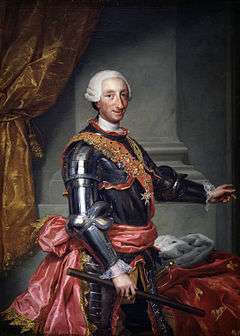 Charles III (10 August 1759 – 14 December 1788) | |||||
| - | 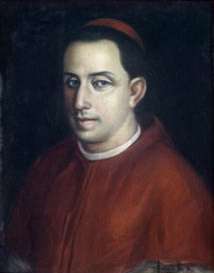 |
Archbishop Manuel Rojo del Río y Vieyra (acting) |
July 1761 | October 6, 1762 |  Charles III |
British Occupation of Manila (1761–1764)
After the Battle of Manila on 1762, on a terrible loss, the Philippines was occupied by 2 Governors-General of the United Kingdom or the British Empire.
Great Britain occupied Manila and the naval port of Cavite as part of the Seven Years' War.
| # | Picture | Name | From | Until | Monarch |
|---|---|---|---|---|---|
| 43 | _Pillars_of_Hercules_Variant.svg.png) |
Simón de Anda y Salazar (Provisional Government in Bacolor, Pampanga) |
October 6, 1762 | February 10, 1764 |  Charles III |
| 44 | .svg.png) |
Dawsonne Drake | November 2, 1762 | May 31, 1764 | 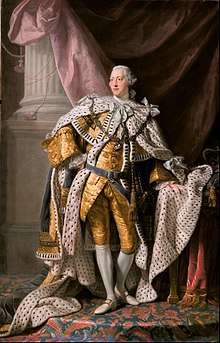 George III |
Under New Spain (1764–1821)
After the British Government replaced their incumbent Governor-General of the Philippines and they have given the nation to Spain one more time, Spanish Governor-General Francisco Javier de la Torre ascended to the Seat.
| # | Picture | Name | From | Until | Monarch |
|---|---|---|---|---|---|
| 45 | _Pillars_of_Hercules_Variant.svg.png) |
Francisco Javier de la Torre | March 17, 1764 | July 6, 1765 |  Charles III |
| 46 | _Pillars_of_Hercules_Variant.svg.png) |
José Antonio Raón y Gutiérrez | July 6, 1765 | July 1770 | |
| (43) | _Pillars_of_Hercules_Variant.svg.png) |
Simón de Anda y Salazar | July 1770 | October 30, 1776 | |
| 47 | _Pillars_of_Hercules_Variant.svg.png) |
Pedro de Sarrio | October 30, 1776 | July 1778 | |
| 48 | 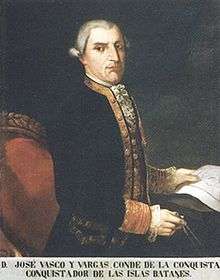 |
José Basco y Vargas | July 1778 | September 22, 1787 | |
| (47) | _Pillars_of_Hercules_Variant.svg.png) |
Pedro de Sarrio | September 22, 1787 | July 1, 1788 | |
| 49 | 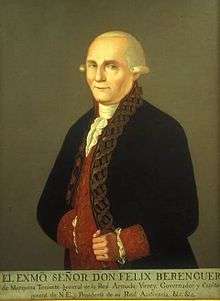 |
Félix Berenguer de Marquina | July 1, 1788 | September 1, 1793 | |
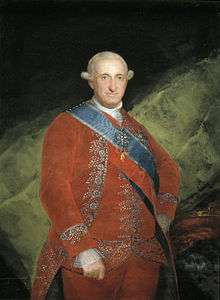 Charles IV | |||||
| 50 | _Pillars_of_Hercules_Variant.svg.png) |
Rafael María de Aguilar y Ponce de León | September 1, 1793 | August 7, 1806 | |
| 51 | _Pillars_of_Hercules_Variant.svg.png) |
Mariano Fernández de Folgueras | August 7, 1806 | March 4, 1810 | |
_by_Goya.jpg) Ferdinand VII | |||||
 Joseph Bonaparte | |||||
| 52 | _Pillars_of_Hercules_Variant.svg.png) |
Manuel Gonzalez de Aguilar | March 4, 1810 | September 4, 1813 | |
| 53 | _Pillars_of_Hercules_Variant.svg.png) |
José Gardoqui Jaraveitia | September 4, 1813 | December 10, 1816 | |
_by_Goya.jpg) Ferdinand VII | |||||
| (51) | _Pillars_of_Hercules_Variant.svg.png) |
Mariano Fernández de Folgueras | December 10, 1816 | September 15, 1821 |
Direct Spanish control (1821–1898)
After the 1821 Mexican War of Independence, Mexico became independent and was no longer part of the Spanish Empire. The Viceroyalty of New Spain ceased to exist. The Philippines, as a result, was directly governed from Madrid, under the Crown.
| # | Picture | Name | From | Until | Monarch |
|---|---|---|---|---|---|
| (51) | _Pillars_of_Hercules_Variant.svg.png) |
Mariano Fernández de Folgueras | September 16, 1821 | October 30, 1822 |  Ferdinand VII |
| 54 | _Pillars_of_Hercules_Variant.svg.png) |
Juan Antonio Martínez | October 30, 1822 | October 14, 1825 | |
| 55 | _Pillars_of_Hercules_Variant.svg.png) |
Mariano Ricafort Palacín y Abarca | October 14, 1825 | December 23, 1830 | |
| 56 | 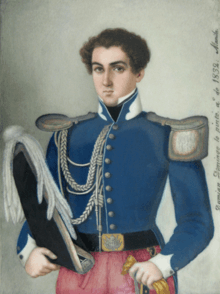 |
Pasqual Enrile y Alcedo | December 23, 1830 | March 1, 1835 | |
 Isabella II | |||||
| 57 | _Pillars_of_Hercules_Variant.svg.png) |
Gabriel de Torres | March 1, 1835 | April 23, 1835 | |
| 58 | _Pillars_of_Hercules_Variant.svg.png) |
Joaquín de Crámer | April 23, 1835 | September 9, 1835 | |
| 59 | _Pillars_of_Hercules_Variant.svg.png) |
Pedro Antonio Salazar Castillo y Varona | September 9, 1835 | August 27, 1837 | |
| 60 | _Pillars_of_Hercules_Variant.svg.png) |
Andrés García Camba | August 27, 1837 | December 29, 1838 | |
| 61 | _Pillars_of_Hercules_Variant.svg.png) |
Luis Lardizábal | December 29, 1838 | February 14, 1841 | |
| 62 | 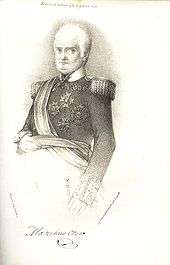 |
Marcelino de Oraá | February 14, 1841 | June 17, 1843 | |
| 63 | _Pillars_of_Hercules_Variant.svg.png) |
Francisco de Paula Alcalá de la Torre | June 17, 1843 | July 16, 1844 | |
| 64 |  |
Narciso Clavería, 1st Count of Manila | July 16, 1844 | December 26, 1849 | |
| 65 | _Pillars_of_Hercules_Variant.svg.png) |
Antonio María Blanco | December 26, 1849 | July 29, 1850 | |
| 66 | 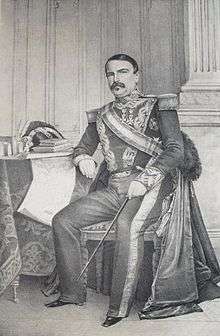 |
Antonio de Urbistondo y Eguía | July 29, 1850 | December 20, 1853 | |
| 67 | _Pillars_of_Hercules_Variant.svg.png) |
Ramón Montero y Blandino | December 20, 1853 | February 2, 1854 | |
| 68 | 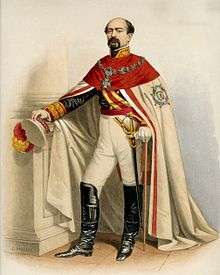 |
Manuel Pavía, 1st Marquis of Novaliches | February 2, 1854 | October 28, 1854 | |
| (67) | _Pillars_of_Hercules_Variant.svg.png) |
Ramón Montero y Blandino | October 28, 1854 | November 20, 1854 | |
| 69 | _Pillars_of_Hercules_Variant.svg.png) |
Manuel Crespo y Cebrían | November 20, 1854 | December 5, 1856 | |
| (67) | _Pillars_of_Hercules_Variant.svg.png) |
Ramón Montero y Blandino | December 5, 1856 | March 9, 1857 | |
| 70 | 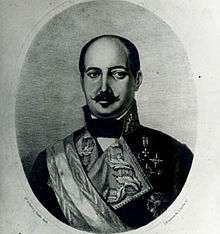 |
Fernándo Norzagaray y Escudero | March 9, 1857 | January 12, 1860 | |
| 71 | _Pillars_of_Hercules_Variant.svg.png) |
Ramón María Solano y Llanderal | January 12, 1860 | August 29, 1860 | |
| 72 | _Pillars_of_Hercules_Variant.svg.png) |
Juan Herrera Dávila | August 29, 1860 | February 2, 1861 | |
| 73 | _Pillars_of_Hercules_Variant.svg.png) |
José Lemery e Ibarrola Ney y González | February 2, 1861 | July 7, 1862 | |
| 74 | _Pillars_of_Hercules_Variant.svg.png) |
Salvador Valdés | July 7, 1862 | July 9, 1862 | |
| 75 | _Pillars_of_Hercules_Variant.svg.png) |
Rafaél de Echagüe y Bermingham | July 9, 1862 | March 24, 1865 | |
| 76 | _Pillars_of_Hercules_Variant.svg.png) |
Joaquín del Solar e Ibáñez | March 24, 1865 | April 25, 1865 | |
| 77 | _Pillars_of_Hercules_Variant.svg.png) |
Juan de Lara e Irigoyen | April 25, 1865 | July 13, 1866 | |
| 78 | _Pillars_of_Hercules_Variant.svg.png) |
José Laureano de Sanz y Posse | July 13, 1866 | September 21, 1866 | |
| 79 | _Pillars_of_Hercules_Variant.svg.png) |
Juan Antonio Osorio | September 21, 1866 | September 27, 1866 | |
| (76) | _Pillars_of_Hercules_Variant.svg.png) |
Joaquín del Solar e Ibáñez | September 27, 1866 | October 26, 1866 | |
| 80 |  |
José de la Gándara y Navarro | October 26, 1866 | June 7, 1869 | |
| No Monarch | |||||
| 81 | .svg.png) |
Manuel Maldonado | June 7, 1869 | June 23, 1869 | |
| 82 | 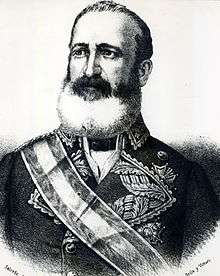 |
Carlos María de la Torre y Navacerrada | June 23, 1869 | April 4, 1871 | |
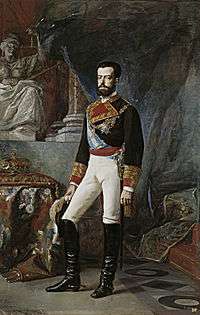 Amadeo I (December 16, 1870 – February 11, 1873) | |||||
| 83 | _Pillars_of_Hercules_Variant.svg.png) |
Rafael de Izquierdo y Gutíerrez | April 4, 1871 | January 8, 1873 | |
| 84 | _Pillars_of_Hercules_Variant.svg.png) |
Manuel MacCrohon | January 8, 1873 | January 24, 1873 | |
| 85 | .svg.png) |
Juan Alaminos y Vivar | January 24, 1873 | March 17, 1874 | |
| No Monarch | |||||
| - | .svg.png) |
Manuel Blanco Valderrama (acting) |
March 17, 1874 | June 18, 1874 | |
| 86 | 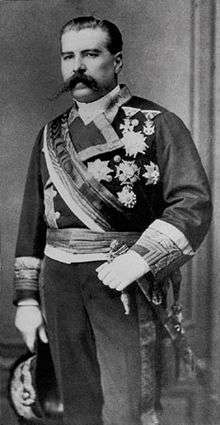 |
José Malcampo y Monje | June 18, 1874 | February 28, 1877 | |
.jpg) Alfonso XII (December 29, 1874 – November 25, 1885) | |||||
| 87 | _Pillars_of_Hercules_Variant.svg.png) |
Domingo Moriones y Murillo | February 28, 1877 | March 20, 1880 | |
| 88 | _Pillars_of_Hercules_Variant.svg.png) |
Rafael Rodríguez Arias | March 20, 1880 | April 15, 1880 | |
| 89 | 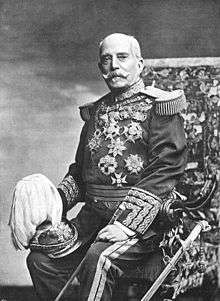 |
Fernando Primo de Rivera, 1st Marquis of Estella | April 15, 1880 | March 10, 1883 | |
| - | _Pillars_of_Hercules_Variant.svg.png) |
Emilio Molíns 1st term, (acting) |
March 10, 1883 | April 7, 1883 | |
| 90 | 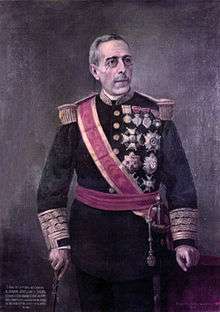 |
Joaquín Jovellar | April 7, 1883 | April 1, 1885 | |
| - | _Pillars_of_Hercules_Variant.svg.png) |
Emilio Molíns 2nd term, (acting) |
April 1, 1885 | April 4, 1885 | |
| 91 | _Pillars_of_Hercules_Variant.svg.png) |
Emilio Terrero y Perinat | April 4, 1885 | April 25, 1888 | |
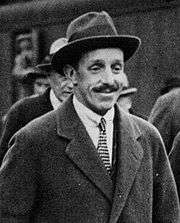 Alfonso XIII (May 17, 1886) | |||||
| - | _Pillars_of_Hercules_Variant.svg.png) |
Antonio Moltó y Díaz Berrio (acting) |
April 25, 1888 | June 4, 1888 | |
| - | _Pillars_of_Hercules_Variant.svg.png) |
Federico Lobatón y Prieto (acting) |
June 4, 1888 | June 5, 1888 | |
| 92 |  |
Valeriano Wéyler | June 5, 1888 | November 17, 1891 | |
| 93 |  |
Eulogio Despujol | November 17, 1891 | March 1, 1893 | |
| - | _Pillars_of_Hercules_Variant.svg.png) |
Federico Ochando (acting) |
March 1, 1893 | May 4, 1893 | |
| 94 |  |
Ramón Blanco, 1st Marquis of Peña Plata | May 4, 1893 | December 13, 1896 | |
| - | 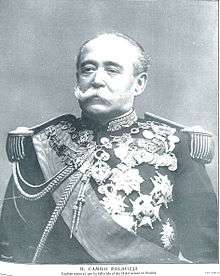 |
Camilo de Polavieja, 1st Marquis of Polavieja (acting) |
December 13, 1896 | April 15, 1897 | |
| - | _Pillars_of_Hercules_Variant.svg.png) |
José de Lachambre (acting) |
April 15, 1897 | April 23, 1897 | |
| 95 |  |
Fernando Primo de Rivera, 1st Marquis of Estella | April 23, 1897 | April 11, 1898 | |
| 96 | 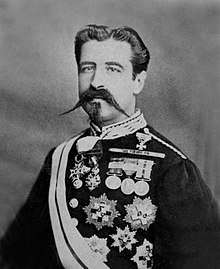 |
Basilio Augustín[1] | April 11, 1898 | July 24, 1898 | |
| - | _Pillars_of_Hercules_Variant.svg.png) |
Fermín Jáudenes[1] (acting) |
July 24, 1898 | August 13, 1898 | |
| - | _Pillars_of_Hercules_Variant.svg.png) |
Francisco Rizzo[1] (acting) |
August 13, 1898 | September 1898 | |
| - | .jpg) |
Diego de los Rios[1] (acting) |
September 1898 | June 3, 1899 |
United States Military Government (1898–1902)
The city of Manila was captured by American expeditionary forces on 13 August 1898.[2] On 14 August 1898 the terms of the Spanish capitulation were signed. From this date, American government in the Philippines begins.[3] General Wesley Merritt, in accordance with the instructions of the United States President, issued a proclamation announcing the establishment of United States military rule.[4]
During the transition period, executive authority in all civil affairs in the Philippine government was exercised by the military governor.
| # | Picture | Name | From | Until | President |
|---|---|---|---|---|---|
| 1 | 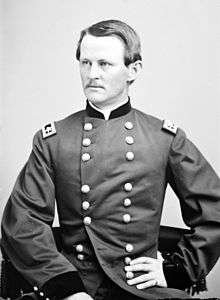 |
Wesley Merritt | August 14, 1898[5] | August 30, 1898[6] |  William McKinley |
| 2 | 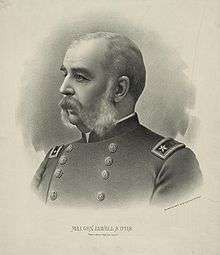 |
Elwell S. Otis | August 28, 1898 | May 5, 1900 | |
| 3 | 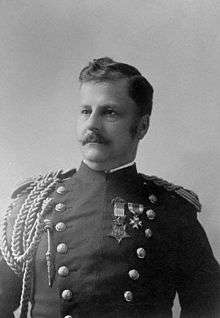 |
Arthur MacArthur, Jr. | May 5, 1900[7] | July 4, 1901 | |
| 4 | 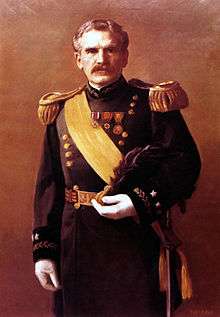 |
Adna Chaffee [8] | July 4, 1901 | July 4, 1902 |
Insular Government (1901–1935)
On July 4, 1901, executive authority over the islands was transferred to the president of the Second Philippine Commission who had the title of Civil Governor, a position appointed by the President of the United States and approved by the United States Senate. For the first year, a Military Governor, Adna Chaffee, ruled parts of the country still resisting the American rule, concurrent with Civil Governor, William Howard Taft.[9] Disagreements between the two were not uncommon.[10] The following year, on July 4, 1902, Taft became the sole executive authority.[8] Chaffee remained as commander of Philippine Division until September 30, 1902.[11]
After his retirement as Civil Governor, Governor Taft was appointed Secretary of War and he secured for his successor the adoption by Congress[12] of the title Governor-General of the Philippine Islands thereby "reviving the high designation used during the last period of Spanish rule and placing the office on a parity of dignity with that of other colonial empires of first importance".[13] The term "insular" (from insulam, the Latin word for island)[14] refers to U.S. island territories that are not incorporated into either a state or a federal district. All insular areas were under the authority of the U.S. Bureau of Insular Affairs, a division of the US War Department.[15][16]
| # | Picture | Name | From | Until | President |
|---|---|---|---|---|---|
| 1 |  |
William Howard Taft | July 4, 1901 | February 1, 1904 |  William McKinley To September 1901 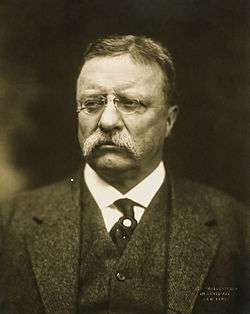 Theodore Roosevelt From September 1901 |
| 2 | 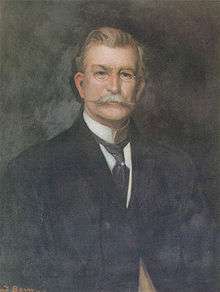 |
Luke Edward Wright | February 1, 1904 | November 3, 1905 |  Theodore Roosevelt |
| 3 | 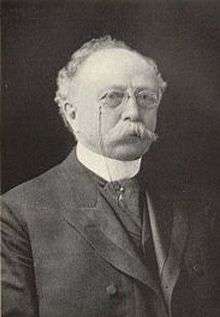 |
Henry Clay Ide | November 3, 1905 | September 19, 1906 | |
| 4 | 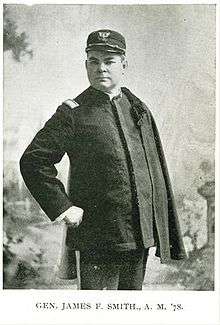 |
James Francis Smith | September 20, 1906 | November 11, 1909 | |
| 5 |  |
William Cameron Forbes | November 11, 1909 | September 1, 1913 |  William Howard Taft |
| - | .jpg) |
Newton W. Gilbert (Acting Governor-General) |
September 1, 1913 | October 6, 1913 | 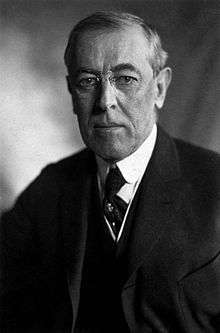 Woodrow Wilson |
| 6 | 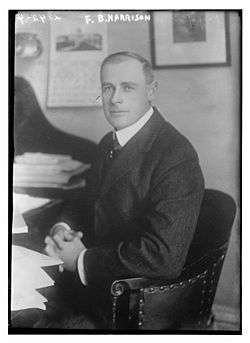 |
Francis Burton Harrison | October 6, 1913 | March 5, 1921 | |
| - | .jpg) |
Charles Yeater (Acting Governor-General) |
March 5, 1921 | October 14, 1921 | 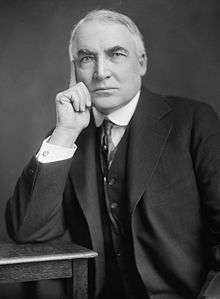 Warren G. Harding To September 1923 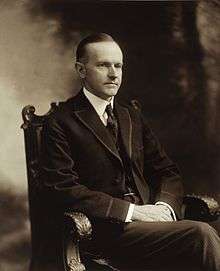 Calvin Coolidge |
| 7 |  |
Leonard Wood | October 14, 1921 | August 7, 1927 | |
| - | .jpg) |
Eugene Allen Gilmore (Acting Governor-General) |
August 7, 1927 | December 27, 1927 |  Calvin Coolidge |
| 8 | 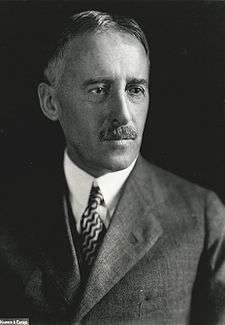 |
Henry L. Stimson | December 27, 1927 | February 23, 1929 | |
| - | .jpg) |
Eugene Allen Gilmore (Acting Governor-General) |
February 23, 1929 | July 8, 1929 |  Herbert Hoover |
| 9 | 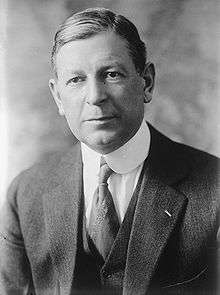 |
Dwight F. Davis | July 8, 1929 | January 9, 1932 | |
| - | .jpg) |
George C. Butte (Acting Governor-General) |
January 9, 1932 | February 29, 1932 | |
| 10 |  |
Theodore Roosevelt, Jr. | February 29, 1932 | July 15, 1933 | |
| 11 |  |
Frank Murphy | July 15, 1933 | November 14, 1935 Became High Commissioner to the Philippines |
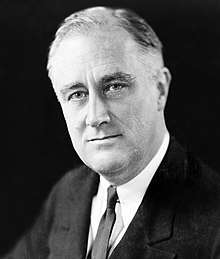 Franklin D. Roosevelt |
High Commissioner to the Philippines (1935–42 and 1945–46)
On November 15, 1935, the Commonwealth of the Philippines was inaugurated as a transitional government to prepare the country for independence. The office of President of the Philippine Commonwealth replaced the Governor-General as the country's chief executive. The Governor-General became the High Commissioner of the Philippines with Frank Murphy, the last governor-general, as the first high commissioner. The High Commissioner exercised no executive power but rather represented the colonial power, the United States Government, in the Philippines. The high commissioner moved from Malacañang Palace to the newly built High Commissioner's Residence, now the Embassy of the United States in Manila.
After the Philippine independence on July 4, 1946, the last High Commissioner, Paul McNutt, became the first United States Ambassador to the Philippines.
| # | Picture | Name | From | Until | President |
|---|---|---|---|---|---|
| 1 |  |
Frank Murphy | November 14, 1935 | 1937 |  Franklin D. Roosevelt |
| 2 | 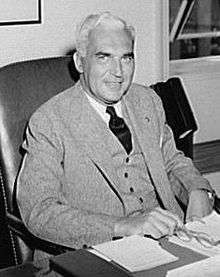 |
Paul V. McNutt | 1937 | 1939 | |
| 3 | 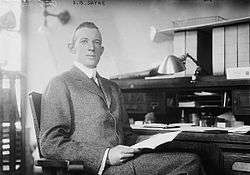 |
Francis Bowes Sayre, Sr. | 1939 | 1942 | |
| 4 |  |
Paul V. McNutt | 1945 | 1946 Following Philippine independence became 1st U.S. Ambassador to the Philippines |
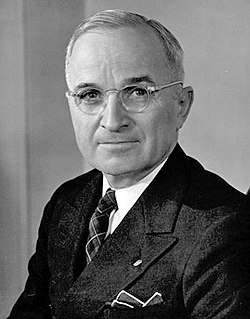 Harry S Truman |
Japanese military governors (1942–1945)
In December 1941, the Commonwealth of the Philippines was invaded by Japan as part of World War II. The next year, the Empire of Japan sent a military governor to control the country during wartime, followed by the formal establishment of the puppet second republic.[17]
| # | Picture | Name | From | Until | Emperor |
|---|---|---|---|---|---|
| 1 | 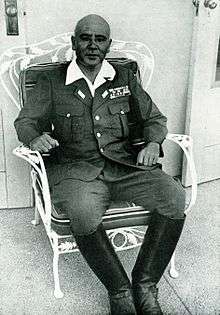 |
Masaharu Homma | January 3, 1942 | June 8, 1942 | 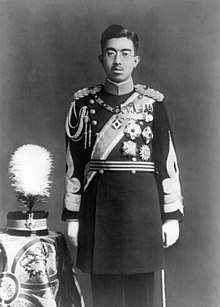 Emperor Hirohito |
| 2 | 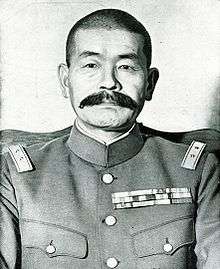 |
Shizuichi Tanaka | June 8, 1942 | May 28, 1943 | |
| 3 |  |
Shigenori Kuroda | May 28, 1943 | September 26, 1944 | |
| 4 |  |
Tomoyuki Yamashita | September 26, 1944 | September 2, 1945 |
On September 2, 1945, the Governor-General position of the Philippines has now been abolished and the Philippines' independence had been proclaimed helped by the United States on the 4th of July 1946 on the presidency of Manuel Roxas. The 4th President of the Philippines.
Timelines
1750–1800

1800–1850

1850–1898
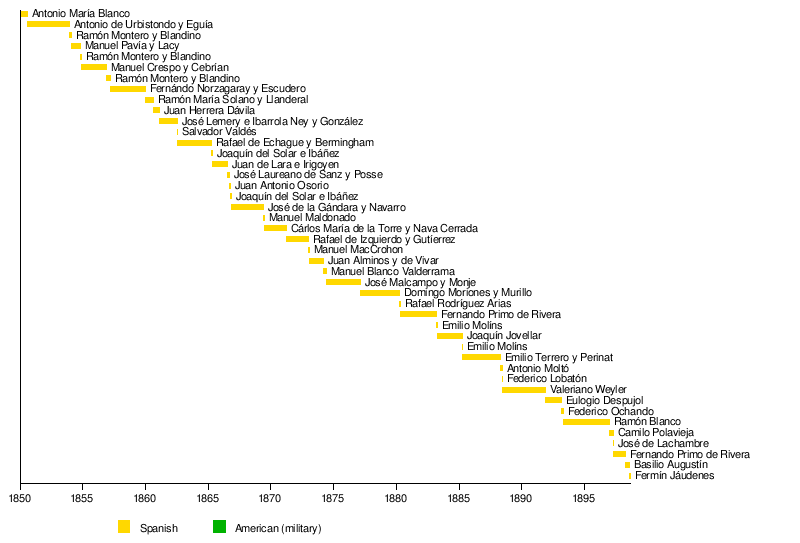
1898–1946
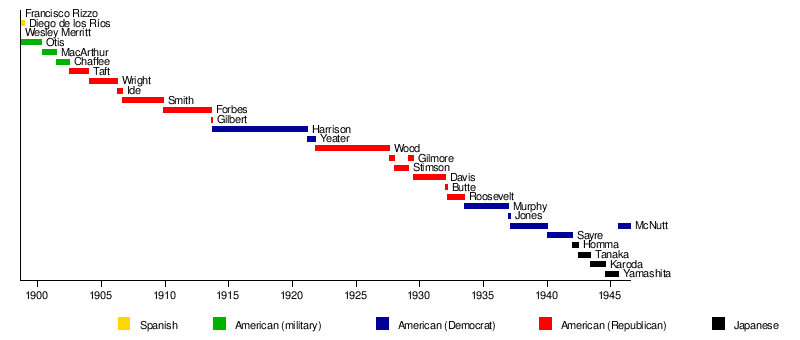
See also
- Filipino styles and honorifics
- List of sovereign state leaders in the Philippines
- List of recorded datu in the Philippines
- President of the Philippines
- List of Presidents of the Philippines
- Audiencia
- List of Viceroys of New Spain
- Spanish Empire
- History of the Philippines
- Military History of the Philippines
- United States Territory
- Governor-General
- Lists of office-holders
- Gobernadorcillo
Notes
- 1 2 3 4 Peterson 2007, p. 11.
- ↑ David P. Barrows; The Governor-General of the Philippines under Spain and the United States; The American Historical Review, Vol. 21, No. 2 (Jan., 1916), pp. 288-311
- ↑ David P. Barrows; The Governor-General of the Philippines under Spain and the United States; The American Historical Review, Vol. 21, No. 2 (Jan., 1916), pp. 288-311
- ↑ David P. Barrows; The Governor-General of the Philippines under Spain and the United States; The American Historical Review, Vol. 21, No. 2 (Jan., 1916), pp. 288-311
- ↑ Halstead, Murat (1898). The Story of the Philippines and Our New Possessions, Including the Ladrones, Hawaii, Cuba and Porto Rico. p. 116.
- ↑ Tucker, Spencer (2009). The Encyclopedia of the Spanish–American and Philippine–American Wars: A Political, Social, and Military History. ABC-CLIO. p. 457. ISBN 978-1-85109-951-1.
- ↑ Pershing, John J. (2013). My Life Before the World War, 1860--1917: A Memoir. University Press of Kentucky. p. 547. ISBN 0-8131-4199-0.
- 1 2 Elliott (1917), p. 509
- ↑ Elliott (1917), p. 4
- ↑ Tanner (1901), p. 383
- ↑ Philippine Academy of Social Sciences (1967). Philippine social sciences and humanities review. pp. 40.
- ↑ Act of Congress of February 6, 1905 entitled: "An Act To amend an Act approved July first, nineteen hundred and two, entitled "An Act temporarily to provide for the administration of the affairs of civil government in the Philippine Islands, and for other purposes," and to amend an Act approved March eighth, nineteen hundred and two, entitled "An Act temporarily to provide revenue for the Philippine Islands, and for other purposes" and to amend an Act March second, nineteen hundred and three, entitled "An Act to establish a standard of value and to provide for a coinage system in the Philippine Islands," and to provide for the more efficient administration of civil government in the Philippine Islands, and for other purposes." Section 8 thereof provided that "the civil governor of the Philippine Islands shall hereafter be known as the governor-general of the Philippine Islands.
- ↑ David P. Barrows; The Governor-General of the Philippines under Spain and the United States; The American Historical Review, Vol. 21, No. 2 (Jan., 1916), pp. 288-311
- ↑ "Island - from English to Latin". Google Translate. Retrieved on 2013-08-07.
- ↑ "Definitions of Insular Area Political Organizations" Archived 2012-09-25 at the Wayback Machine.. U.S. Department of the Interior.
- ↑ "Insular". Merriam-Webster Dictionary. Retrieved on 2013-08-07.
- ↑ Cahoon (2000)
| Wikimedia Commons has media related to Governors-General of the Philippines. |
References
- Governors of the Philippines
- Cahoon, Ben (2000). "Philippines". World's Statesmen.
- Don Peterson (2007-2nd Qtr), 1898: Five Philippine Governors-General Serve Rapid Fire Terms, Philippine Philatelic Journal.
- Tanner, Dr. J.M. (1901-11). Improvement Era Vol.5 No. 1. Church of Jesus Christ of Latter-Day Saints.
- Elliott, Charles Burke (1917). The Philippines: To the End of the Commission Government, a Study in Tropical Democracy. The Bobbs-Merrill Company.
.svg.png)


.svg.png)
.svg.png)
